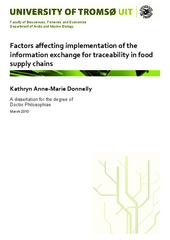The components of a food traceability system
Permanent link
https://hdl.handle.net/10037/13348Date
2018-05-03Type
Journal articleTidsskriftartikkel
Peer reviewed
Abstract
Background: Traceability of food products has become the focus of regional and national legislation, of many research and technical development initiatives and projects, and of many scientific articles. However, most of the scientific publications do not differentiate between the components of a traceability system, and those who do to some degree use inconsistent terminology and definitions. This weakens the analysis and the conclusions, and it can lead to misunderstanding in relation to what a traceability system is, what the components are, and how system functionality can be improved.
Scope and approach: This paper provides a structure for describing and analyzing a traceability system and emphasizes the difference between the system mechanisms as opposed to the attributes of the units that are traced. The basis for the classification outlined in this article is practical experience from traceability system implementations in the food industry, and participation in international standardization processes relating to food traceability. The references and the authors’ experience are from the food sector, but the component description is likely to be relevant and applicable to any product traceability system in a supply chain.
‘Traceability system’ is used as a generic term in this article, encompassing the principles, practices, and standards needed to achieve traceability of food products, regardless of how these are implemented. In practice in the food industry, most traceability systems are computerized and they are implemented through extensive use of information and communications technology (ICT), but in principle a traceability system could be manual and paper-based (as was indeed common practice only a few years ago), and the components hierarchy outlined in this article would still be applicable.
Key findings and conclusions: This paper identifies the general components of a traceability system to be the identification of the units under consideration, the recording of the joining and splitting of these units as they move through the supply chain (the transformations), and the recording of the unit attributes. The distinction between the different components is particularly important when describing and comparing traceability systems, and when recommending improvements. In both these cases, the respective components need to be considered separately.
Description
Is part of
Olsen, P. (2018). Food traceability in theory and in practice. (Doctoral thesis). https://hdl.handle.net/10037/15408Publisher
ElsevierCitation
Olsen, P. & Borit, M. (2018). The components of a food traceability system. Trends in Food Science & Technology, 77, 143-149. https://doi.org/10.1016/j.tifs.2018.05.004Metadata
Show full item recordCollections
Related items
Showing items related by title, author, creator and subject.
-
Factors affecting implementation of the information exchange for traceability in food supply chains
Donnelly, Kathryn Anne-Marie (Doctoral thesis; Doktorgradsavhandling, 2010-11-04)The globalisation and intensification of food production has led to food related health incidents. These incidents range from BSE in cattle to illegally high levels of dioxins in chicken feed (Carriquiry and Babcock, 2007, Caswell, 2000, Elbers et al., 2001, Fallon, 2001, Hobbs, 2004, Madec et al., 2001, Ozawa et al., 2001, Sporleder and Goldsmith, 2001). The modern consumer is increasingly ... -
Application of traceability in deterrence of illegal, unreported and unregulated fishing : an analysis model of EU Regulation 1005/2008 and EU Regulation Proposal 2008/0216 (CNS)
Borit, Melania (Master thesis; Mastergradsoppgave, 2009-05-15)Two of the three new pillars of the European Union Common Fisheries Policy (EU Regulation 1005/2008; EU Regulation Proposal 2008/0216 (CNS)) were explicitly developed to address the illegal, unreported and unregulated fishing concern. These regulations attempt to introduce market monitoring measures that prevent IUU fish from entering legitimate trade channels in the Community. The leading purpose ... -
A Shigella sonnei outbreak traced to imported basil - The importance of good typing tools and produce traceability systems, Norway, 2011
Guzman Herrador, Bernardo; Nilsen, Einar; Cudjoe, Kofitsyo S; Jensvoll, Laila; Kvamme, Jan-Magnus; Lindegård Aanstad, Anja; Lindstedt, Bjørn Arne; Nygård, Karin Maria; Severinsen, G; Werner-Johansen, Ø; Wester, Astrid Louise; Wiklund, Marit; Vold, Line (Journal article; Tidsskriftartikkel; Peer reviewed, 2013)On 9 October 2011, the University Hospital of North Norway alerted the Norwegian Institute of Public Health (NIPH) about an increase in Shigella sonnei infections in Tromsø. The isolates had an identical ‘multilocus variable-number tandem repeat analysis’ (MLVA) profile. Most cases had consumed food provided by delicatessen X. On 14 October, new S. sonnei cases with the same MLVA-profile were reported ...


 English
English norsk
norsk


